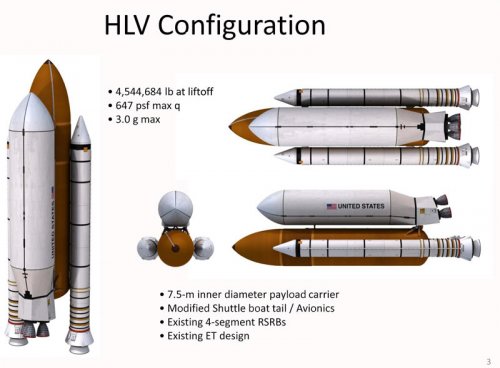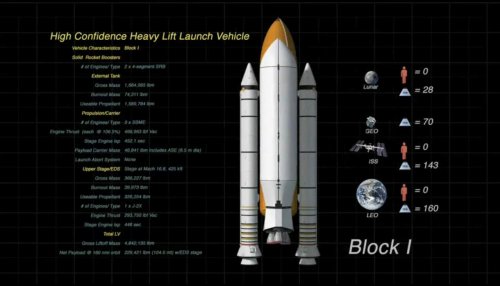This is an interesting project. The Space Shuttle is 99 tonnes empty including 3 tons for OMS propellant and carried 16.05 tonnes to the ISS and could return 14.5 tonnes to Earth and maxed out at 24.4 tonnes. A cargo version replaces the Shuttle with a 33.6 tonne shell and engine pod giving this version a 77 tonne capacity.
Description From Astronautix (itself copied from NASA documentation)
American orbital launch vehicle. NASA Marshall design for a cargo version of the shuttle system. The shuttle orbiter would be replaced by an unmanned recoverable main engine pod. The same concept was studied earlier as the Interim Heavy Lift Launch Vehicle (IHLLV) and as the Class I Shuttle Derived Vehicle (SDV). The Phase I two-SSME configuration would have a payload of 45,000 kg to low earth orbit. Design carried to an advanced phase in 1987-1990, but then abandoned when it was found the concept had no cost advantage over existing expendable launch vehicles.
Status: Study 1989.
Payload: 77,000 kg (169,000 lb).
Thrust: 20,299.20 kN (4,563,442 lbf).
Gross mass: 1,966,675 kg (4,335,776 lb).
Height: 56.00 m (183.00 ft).
Diameter: 8.70 m (28.50 ft).
Apogee: 400 km (240 mi)
After the Challenger accident, NASA believed there would be a need for a 14 per year shuttle launch rate. But such a rate would be unachievable given the existing orbiter flow times and the reduced number of orbiters available. The Shuttle-C (Cargo) would allow such a rate to be achieved. After Challenger, NASA studied development of a new unmanned Heavy Lift Launch Vehicle with the Air Force. In the discussions NASA insisted that any HLLV be a Shuttle Derived Vehicle. This led to the USAF pulling out of the shuttle program, and developing the Titan IV for the short term, and beginning a study of a new ALS Advanced Launch System for the long term. The USAF did not believe low-cost access to space was possible using man-rated systems. In the aftermath of the kerfuffle a Joint NASA-DoD-USAF steering group was set up to monitor development of the ALS and Shuttle-C. In August 1987 NASA Houston officially began Shuttle-C studies through assignment of a task team. In November 1987 nine-month study contracts were let to Martin-Marietta, United Space Boosters Inc, and Rockwell for definition of a Shuttle-Derived Vehicle. Phase I of the studies was to determine the optimum vehicle configuration, and Phase II was to completely define the selected vehicle. Concept studied included:
- A throwaway orbiter with no wings, crew cabin, or avionics, and only two engines. This idea was abandoned early.
- In-line versions with one to three SSME engines at the base of the external tank, and the payload on top. But this was found to require extensive facility modifications as well as redesign of the external tank
- Class I Shuttle Derived Vehicle as had been proposed in studies of the 1970's.
The Class I SDV was again found to be the best solution. It was estimated it could deliver payload to orbit at a cost of $4400/kg, as opposed to $1720 for the Delta II, $ 1800 for the Titan IV, or $ 3400 for the shuttle. As a result a Request for Proposal was issued for the Expendable Cargo Element - a payload fairing for the Shuttle-C to be mounted on the side of the external tank. This could accommodate 4.6 m x 22 m payloads weighing up to 47,000 kg and would be delivered into a 407 km / 28.5 deg orbit for docking with Space Station Freedom. The system could also deliver 52,000 kg to a 300 km / 28.5 deg orbit. The CE (Cargo Element) was equipped with 2 Space Shuttle Main Engines, and 2 Orbital Maneuvering System pods. The payload would either be released attached to the planned Orbital Maneuvering Vehicle transfer stage, or an OMV already in orbit would dock with the CE and take the payload away; or the OMS itself would be used to put the payload in its final orbit, release it, then retrofire to return the CE to earth.
In February 1988 the industrial team Rockwell - Martin Marietta - Boeing - Teledyne - Intermetrics - United Space Boosters was awarded follow-on18-month study contract NAS8-37144. During the course of the study NASA canceled the OMV, and the design had to be modified to handle in-orbit delivery and release of the payloads. The final report of the study envisioned two generations of Shuttle-C's. Generation 1 would be an expendable CE with a 4.6 m x 24.7 m cargo bay, using two SSME's, and capable of delivering 45,000 kg to orbit. The CE would have an empty weight of 31,750 kg, using the shuttle thrust structure, and be fitted with shuttle engines and computers at the end of their useful lives. Three to four flights per year could be accomplished using the expendable approach, while NASA believed it had a requirement for 10 to 12 per year. Generation 2 would have a new-design recoverable CE, powered by 3 SSME's, and capable of delivering 77,000 kg in a 7.3 m x 29.3 m volume.
In early 1989 the study contract was extended by one year, including consideration of use of the Centaur G-Prime from the Titan IV as an upper stage. It was determined that the MPTA-098 structural article built in the 1970's for the SSME development program could be used as the Shuttle-C prototype. At the end of the study NASA decided that the development cost for Shuttle-C would be $ 1.8 billion. The Office for Technology Assessment estimated the cost as only $985 million, a rare case indeed where NASA made a high-ball estimate. Cost per launch would be $424 million for the Generation 1 design, or $9350 per kg. 14 Space Shuttles and 10 Shuttle-C's could be launched per year using existing Kennedy Space Center facilities. However such a rate would quickly exhaust the supply of surplus SSME engines. Therefore new-build engines would have to be purchased at a cost of $38 million each, or a total of $500 million per year. When this cost was taken into consideration, Shuttle-C was more expensive than the USAF Titan IV - therefore, NASA concluded, there was no reason to develop it. The decision was taken in 1990 to cancel Shuttle-C.
LEO Payload: 77,000 kg (169,000 lb) to a 400 km orbit at 28.00 degrees.
Flyaway Unit Cost 1985$: 84.970 million.
Stage Data - Shuttle C
- Stage 0. 2 x Shuttle SRB. Gross Mass: 589,670 kg (1,299,990 lb). Empty Mass: 86,183 kg (190,000 lb). Thrust (vac): 11,519.999 kN (2,589,799 lbf). Isp: 269 sec. Burn time: 124 sec. Isp(sl): 237 sec. Diameter: 3.71 m (12.17 ft). Span: 5.10 m (16.70 ft). Length: 38.47 m (126.21 ft). Propellants: Solid. No Engines: 1. Engine: SRB. Other designations: Solid Rocket Booster. Status: In Production.
- Stage 1. 1 x Shuttle Tank. Gross Mass: 750,975 kg (1,655,616 lb). Empty Mass: 29,930 kg (65,980 lb). Isp: 455 sec. Burn time: 480 sec. Isp(sl): 363 sec. Diameter: 8.40 m (27.50 ft). Span: 8.70 m (28.50 ft). Length: 46.88 m (153.80 ft). Propellants: Lox/LH2. No Engines: 0. Engine: None. Other designations: External Tank. Status: Out of production.
- Stage 2. 1 x Shuttle C. Gross Mass: 36,360 kg (80,160 lb). Empty Mass: 34,380 kg (75,790 lb). Thrust (vac): 6,834.303 kN (1,536,412 lbf). Isp: 313 sec. Burn time: 120 sec. Diameter: 6.30 m (20.60 ft). Span: 6.30 m (20.60 ft). Length: 21.00 m (68.00 ft). Propellants: N2O4/MMH. No Engines: 2. Engine: OME. Other designations: IHLLV; Interim Heavy Lift Launch Vehicle. Status: Study 1980.


